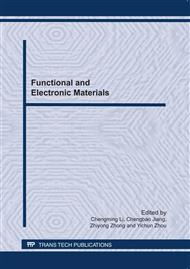[1]
Jitendra K Pandey, K Raghunat ha Reddy, A Prat heep Kumar and R.P. Singh: Polym. Degrad. Stab. Vol. 88(2005), p.234.
Google Scholar
[2]
C.W. Tang and S.A. Vanslyke: Appl. Phys. Lett. Vol. 51(1987), p.913.
Google Scholar
[3]
J.H. Burroughes, D.D.C. Bradley, A.R. Brown, R.N. Marks, K. Mackay, R.H. Friend, P.L. Burns and A.B. Holmes: Nature Vol. (1990), p.347.
Google Scholar
[4]
Wang Xin, Shen Juan and Xu Hongyao: Journal of Functional Materials Vol. 39(2008), p.1555.
Google Scholar
[5]
Zhang Xiaobing, Zhang Zimin, Zhang Yugui and Li Min: Chinese Journal of Organic Chemistry Vol. 29(2009), p.297.
Google Scholar
[6]
Peng Zhang, Benchen Tang, Wenjing Tian, Bing Yang and Min Li: Mater. Chem. Phys. Vol. 119(2010), p.243.
Google Scholar
[7]
Yuan Ji Bing, Louis M. Leung and Gong Menglian: Tetrahedron Lett. Vol. 45(2004), p.6361.
Google Scholar
[8]
Ruiping Deng, Jiangbo Yu, Hongjie Zhang, Liang Zhou, Zeping Peng, Zhefeng Li and Zhiyong Guo: Chem. Phys. Lett. Vol. 443(2007), p.258.
Google Scholar
[9]
Tamao K, Uchida M, Izumizawa T, Furukawa K and Yamag-uchi S: J . Am. Chem. Soc. Vol. 118(1996), p.11974.
Google Scholar
[10]
Akira Adachi, Hiroyuki Yasuda, Takanobu Sanji, Hideki Sakurai and Koichi Okita: J. Lumin. Vol. 87-89(2000), p.1174.
Google Scholar
[11]
Murata H, Kafafi Z H and Uchida M: Appl. Phys. Lett. Vol. 80(2002), pp.189-191.
Google Scholar
[12]
Leonidas C. Palilis, Hideyuki Murata, Manabu Uchida and Zakya H. Kafafi: Org. Electron. Vol. 4(2003), p.113.
Google Scholar
[13]
Richard A. Klenkler, Hany Aziz, An Tran, Zoran D. Popovic and Gu Xu: Org. Electron. Vol. 9(2008), p.285.
Google Scholar
[14]
Hsiao Fan Chen, Shang Jung Yang, Zhen Han Tsai, Wen-Yi Hung, Ting-Chih Wang and Ken-Tsung Wong: J. Mater. Chem. Vol. 19(2009), p.8112.
Google Scholar
[15]
Toshinori Matsushima, Mayumi Takamori , Yuichi Miyashita, Yoko Honma, Tsuyoshi Tanaka, Hidenori Aihara, and Hideyuki Murata: Org. Electron. Vol. 11(2010), p.16.
Google Scholar
[16]
Li Tingxi, Takashi Yamamoto, Hsing-Lin Lan and Junhi Kido: Polym. Adv. Technol. Vol. 15(2004), p.266.
Google Scholar
[17]
Li Tingxi, Hidehito Fukuyama, Yoshinori Yamagata, Hsing-Lin Lan and Junhi Kido: Polym. Adv. Technol. Vol. 15(2004), p.302.
Google Scholar
[18]
Li Tingxi and Junji Kido: Ploymer Preprints Vol. 51(2002), p.791.
Google Scholar
[19]
Abhishek P. Kulkarni, Christopher J. Tonzola, Amit Babel and Samson A. Jenekhe: Chem. Mater. Vol. 16(2004), p.4556.
Google Scholar
[20]
Vasilis P. Barberis, John A. Mikroyannidis and Ioakim K. Spiliopoulos: Synth. Met. Vol. 157(2007), p.475.
Google Scholar
[21]
Andrzej Danel, Ewa Gondek and Iwan Kityk: Opt. Mater. Vol. 32(2009), p.267.
Google Scholar


